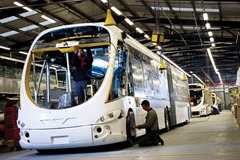Mixed prospects for manufacturing
 Rising manufacturing output is driving recovery but industry leaders are seeking more action on rates and energy costs.
Rising manufacturing output is driving recovery but industry leaders are seeking more action on rates and energy costs.
Despite experiencing steady decline over recent decades, particularly in the traditional areas of shipbuilding and textiles, Northern Ireland’s manufacturing sector is currently showing signs of robust good health. Not only has the long-term decline in manufacturing largely halted, despite the carnage of the recent global economic downturn, the latest economic data indicate that manufacturing is one of the sectors of the economy actually contributing most positively at the forefront of the recovery now underway.
Although manufacturing output and employment fell sharply in the recent recession, most of the lost ground over that period has already been recaptured.
The latest Department of Enterprise, Trade and Investment economic bulletin (June 2014) indicates that in the year to Q1 2014, production output in the manufacturing sector grew by 6.9 per cent year-on-year. Much of this was accounted for by success in specific sub-sectors such as the chemicals and pharmaceuticals sector where home grown players Almac, Norbrook and Randox and others contributed to a 14 per cent rise in output year-on-year.
Other sectors to perform well include rubber and plastics and also construction machinery where Northern Ireland is a major global player in quarrying equipment. Recovery in the construction sector generally has led to an upsurge in demand for manufactured construction materials, both for export and domestic consumption. And, of course, the most eye-catching success has been achieved in the transport-related equipment manufacturing sector where Bombardier, Wrightbus, Schrader Electronics and others have been expanding on the back of very full order books. Indeed the high profile success of Wrightbus in winning multiple export contracts for its new generation buses has come to symbolise the new found confidence in the manufacturing sector.
The food and beverages subsector has also enjoyed strong growth in recent times.
In addition, successive surveys carried out by the Northern Ireland Chamber of Commerce (in association with BDO) reveal growing business optimism and indications that there will be further output and employment growth in the manufacturing sector in the period ahead. This view is reinforced by further evidence from the Ulster Bank’s Purchasing Managers Index (PMI) surveys.
Manufacturing employment in Northern Ireland has now stabilised at around 80,000 direct employees, (having fallen as low as 73,000 in 2010) although it supports many tens of thousands of jobs in related services sub-sectors. This number is only slightly lower than the pre-economic downturn figure of 84,000 in 2007. The sector also accounts for the lion’s share of all production in the Northern Ireland economy and in the region of £18 billion in sales annually, most of which are exports.
However, it is not all plain sailing just yet for manufacturing in Northern Ireland. The recovery is still in its very early stages and there are a number of negative factors impacting on overall manufacturing competitiveness. Some economists will point out that Northern Ireland manufacturing has lower productivity than the UK average and well below that achieved in other developed economies. A consequence of this is comparatively lower wages. However, the sectoral representative group Manufacturing Northern Ireland points to other challenges facing the sector such as uncertainty about rates increases and persistently high energy costs. There is also the upward pressure on wage costs exacerbated by comparatively high remuneration levels in the public sector.
These well-understood problems are not within the control of the manufacturing sector itself. However, it is widely believed that if the Executive could intervene more to address rates increases and energy costs then there is nothing stopping the sector from building strongly on its current success.





